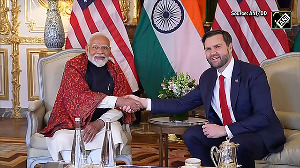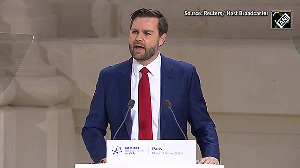Financial markets both in India and globally have been gripped by fear and panic in recent weeks. In no particular order, investors have been worried about global recession, stagflation or a systemic collapse of the entire financial architecture in the United States.
In India, we have had the additional concerns of a possible early election and political uncertainty. In the last week, as oil has finally started to retreat, hopes have been expressed that just maybe we have seen the bottom in financial markets, both in India and globally.
How justified is this hope? Could we have bottomed?
To have the confidence that we may have seen the worst, we need two or three things to fall into place globally, and India has other specific issues it needs to address.
First of all, unless oil comes down by another 15-20 per cent and stays down, it is unlikely that global or Indian markets can make much progress. Although it is too early to tell, the recent sharp drop in crude could be the long-awaited and sustained correction.
Demand destruction is now clear globally, with fundamental shifts in consumer behaviour beginning to take place in the OECD economies. Oil consumption is dropping across the developed world.
As subsidies are being narrowed in Asia, higher prices should start biting here as well.
The negative reaction in global equities to rising crude prices also highlights their impact on global growth and the self-limiting nature of the recent rise in oil prices.
In the recent oil price blow-off, stocks of oil companies have not fully participated; this divergence between oil and oil stocks highlights investors' concerns on the sustainability of current elevated prices.
Oil has been the ultimate momentum trade, and thus when it does break, we could easily see prices going into free-fall.
Many investors still question that with China being the source of marginal demand and still growing at 10 per cent, how can crude prices come off? The answer lies in the actual contraction in crude demand among the OECD economies.
As a bloc, the OECD consumes far more crude than China, and the demand contraction here will eventually swamp any demand increases coming out of China. In fact, we may already be at this point. The recent hikes in fuel prices in China, as well as an anticipated slowing of its economy, will also cool down the demand side.
With demand and supply getting more aligned, the only joker in the pack remains geopolitical concerns. This is inherently unpredictable and any one event can cause a steep spike at any time.
If the recent oil price correction can extend and sustain, then one of the critical building blocks to a market base building will be in place.
The second big drag has been inflation and the rising CPI (consumer price index). While the US authorities have been able to get away with focusing only on the core CPI (ex food and energy prices), most central bankers have to answer to the headline CPI numbers, which are elevated and rising globally.
These rising price levels put significant constraints on what the central banks can do to stabilise both the markets and the real economy. The US economy and its financial markets have been hit by a serious deleveraging cycle combined with falling asset prices, and this is now beginning to spill over into the United Kingdom and Western Europe.
Such severe asset price deflation and deleveraging need aggressive monetary reflation to counter it, but high and rising inflation is preventing the authorities from easing as much as they would like to.
For example in the US, borrowing rates for both businesses and consumers are actually higher today than before the Fed began cutting, yet (US Fed chairman) Bernanke is now being forced to talk about inflation risks and pause his easing cycle. In Europe, despite growth slowing, the ECB has actually hiked rates to counter rising headline inflation.
The UK is another example of the policy dilemma, property prices are falling, the financial system is in stress and growth severely compromised, yet the Bank of England is unable to ease because of elevated food and energy prices.
The monetary authorities are losing their ability to engineer a soft landing, which is dangerous and could lead to far more volatile economic outcomes than we are used to. The potential inability of the central banks to act as countercyclical economic shock absorbers is very serious and could lead to higher risk premiums across asset classes.
We need to see both food and energy prices come down, and headline CPI start to fall. This will allow central bankers globally to focus on stabilising the financial system, counter deleveraging and cushion falling asset prices.
Headline inflation has to come down, as unilateral monetary easing from the Fed will not be effective. If only the Fed eased, it will pressurise the dollar and spike commodity prices, the ECB and BoE have to join this party, and they will ease only if headline CPI comes down.
Subdued inflation will also take out of the equation the 70s-style stagflation, the collapsing PE scenario that some of the bears have been pointing to as the template for the markets.
In India beyond the above, we need to see some movement on reforms from this government. While measures like hiking FDI in insurance, changing voting rights in the PSU banks, etc have limited real world impact, reforms will boost sentiment considerably. The one measure with serious longer-term positives is pension reform.
The Indian economy is slowing, and earnings are at greater risk than most realise. With earnings disappointments likely, sentiment and its impact on PE multiples will be the key to support the market.
If investors are confident on economic policy making, then they will be willing to look through short-term earnings weakness; otherwise we run the risk of both weak earnings and multiple contraction.
India is a consensus underweight among fund managers, and money has continued to move out of the country over the last six months. However, the market is not yet cheap enough to attract the value buyers.
Either we wait for 12-18 months to let earnings grow and bring valuations down further, or we need to rekindle excitement on the country and its long-term growth trajectory through demonstrated economic reform and policy action.
There seems to be some light at the end of the tunnel for global equity markets, but it is too early to wave the all clear flag. We need to see continued movement on oil and inflation.
In India, we need to demonstrate our desire and commitment to sustain our growth trajectory, through economic policymaking and fundamental reform, both of which have been totally lacking over the last few years.







 © 2025
© 2025